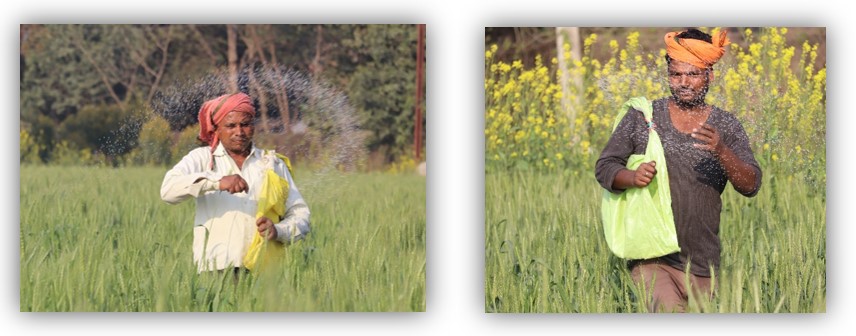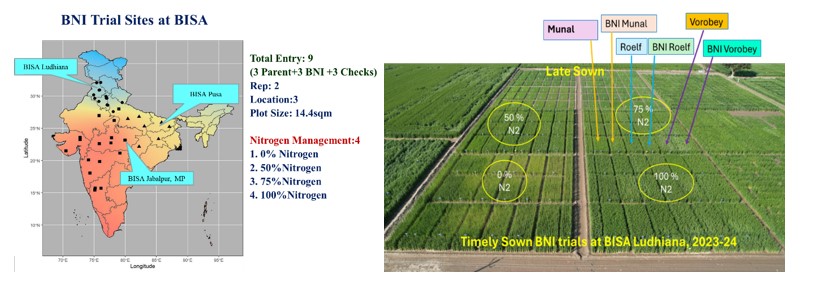Mitigating Fertilizer Subsidy Burden: The Promise of BNI-Enabled Wheat Varieties in India
Manish K. Vishwakarma, Pradeep K. Bhati, and Arun K. Joshi
The Indian government’s hefty fertilizer subsidy highlights fertilizers’ vital role in boosting agricultural productivity. Farmers can buy urea at a regulated maximum retail price (MRP) through the urea subsidy program. A 45-kilogram bag of urea is priced at ₹242 per bag (excluding taxes and neem coating fees), while the actual cost can range from ₹2,200 to ₹3,000. The government provides the difference between the farm gate delivered cost and the net market realization to urea manufacturers or importers as a subsidy. Despite a revised estimate of ₹1.29-lakh crore, data from Business Line (Source: Ministry of Chemicals and Fertilizers demand no 6 Department of Fertilizers, 2024-25) shows the urea subsidy rose above ₹1.30-lakh crore. However, this spending also poses significant economic and environmental challenges. Developing Biological Nitrification Inhibition (BNI)-enabled varieties is a promising solution to alleviate these issues. A robust breeding program to develop BNI wheat varieties is already underway in India through collaboration among ICAR-JICA/JIRCAS-BISA-CIMMYT.

What is BNI?
Biological nitrification inhibition (BNI) is the natural ability of certain plants (especially certain genotypes) to curb soil nitrification. These plants release compounds from their roots that inhibit nitrifying bacteria, reducing the conversion of ammonium to nitrate. Nitrification can lead to substantial nitrogen losses through gaseous emissions and leaching, diminishing fertilizer effectiveness and polluting water sources.
How BNI-Enabled Varieties Can Help: BNI wheat varieties can help Indian agriculture in the following ways.
- Enhanced Nitrogen Use Efficiency (NUE): BNI-enabled varieties allow farmers to utilize applied fertilizers more effectively by minimizing nitrogen losses up to 20 to 30%. This translates to higher yields with lower input costs.
- Reduced Fertilizer Dependency: Increased NUE can reduce the overall amount of fertilizer required, lowering the government’s subsidy burden.
- Environmental Benefits: Reduced nitrogen losses minimize groundwater contamination and greenhouse gas emissions, contributing to a more sustainable agricultural system.
- Farmer Profitability: Higher yields and reduced input costs can significantly boost farmers’ incomes.
How does BNI work?
- Some wheat varieties exude BNI compounds like phenolic acids or other secondary metabolites from their roots.
- These compounds target ammonia-oxidizing bacteria (AOB) and archaea, which are responsible for the first step of nitrification.
- By suppressing these microbes, BNI slows down the transformation of NH₄⁺ to NO₃
BNI-Wheat Research in India:
Breeding for BN wheat in India has its genesis in the JIRCAS-CIMMYT collaboration that produced pre-bred BNI wheat lines after years of hard work. Once those pre-breeding lines became available, a discussion between Arun Joshi (BISA) and Dr Subbarao (JIRCAS) resulted in a project grant by JICA on April 11, 2022. This project, “Establishment of Nitrogen-Efficient Wheat Production Systems in Indo-Gangetic Plains by the Development of BNI Technology,” involved BISA, the three ICAR institutions (IIWBR and CSSRI in Karnal and IARI in New Delhi), and JIRCAS, Japan. Although BISA initiated testing and breeding BNI varieties in 2020, the project began a full-fledged breeding program involving all partners. In addition, this project has evaluated parental BNI lines under different fertilizer doses, and BNI lines were found superior to non-BNI in low (75%) nitrogen doses.

Since then, significant progress has been made in developing wheat varieties with the BNI trait.
The BNI-derived lines (BNI-Munal, BNI-Roelf, and BNI-Vorobey) were used as the donor and crossed/backcrossed with several newly released varieties for different wheat-growing zones of India (DBW 303, DBW 187, DBW 222, DBW 110, DBW 252 DBW 327 HI 1612 and 7 CIMMYT Advanced lines). These lines have been tested for all diseases and all other important agronomic traits. The best lines will be screened for Ug99 and wheat blast in Kenya and Bangladesh, respectively. By the next two years (2026 and 2027), a few BNI lines are expected to find a place in the all-India coordinated trials.
Implementing BNI-Enabled Varieties: The realization of BNI wheat varieties in farmers’ fields will require several steps, as mentioned below:
• Research and Development: Continued research is crucial to identifying and developing high-yielding BNI-enabled varieties for various crops and agroclimatic zones in India. This aligns with ongoing efforts to strengthen breeding and seed systems in crops such as wheat, maize, and millet.
• Seed System Strengthening: Establishing a robust seed system is essential to ensure the availability and accessibility of quality BNI-enabled seeds to farmers. Initiatives like the project on seed production systems in Bihar can serve as a model.
• Extension Services: Effective extension programs are needed to educate farmers about the benefits of BNI-enabled varieties and provide them with the necessary knowledge and skills for successful cultivation. Leveraging capacity-building programs and predictive breeding tools can accelerate adoption.
• Policy Support: Government policies should incentivize the breeding and adoption of BNI-enabled varieties. Policies promoting stress-tolerant varieties can serve as a template for integrating BNI varieties into existing frameworks.
In this context, scientists from around the world, working on integrating the BNI trait into crops like wheat, sorghum, and paddy, convened at the 5th BNI-International consortium biennial meeting from December 3-6, 2024, at the International Congress Center “EPOCHAL TSUKUBA” in Japan. They participated in brainstorming sessions and presented current updates and future perspectives on breeding BNI varieties of crops, mainly wheat. From India, the scientific team was led by Prof. Arun K Joshi, Managing Director of BISA, and Dr. T.R. Sharma, Deputy Director General (Crop Science) at ICAR. The Indian participants included Dr. RK Yadav, Director, CSSRI Karnal, Dr. SC Bhardwaj, Dr. CN Mishra, Dr. PK Bhati, and Dr. MK Vishwakarma. They also participated in the CropSustaiN: Partnering with the global BNI-Wheat Mission – Develop Give/Take Linkages on December 6 in Tsukuba, Japan.

Conclusion:
BNI-enabled varieties offer a sustainable and economically viable solution to mitigate the challenges associated with fertilizer subsidies in India. Significant progress has been made in the wheat crop to develop BNI varieties. By promoting increased NUE, reducing environmental impact, and enhancing farmer profitability, these varieties can contribute significantly to a more sustainable and resilient agricultural sector. BNI lines have shown promise under Indian conditions. The BNI breeding pipeline is in the advanced stage through the JICA-funded project involving BISA and ICAR institutes (IIWBR, IARI, and CSSRI). There is a high expectation that BNI lines might be in national trials in India in the next 2 years. By working together, scientists, policymakers, and farmers can make BNI wheat a cornerstone of sustainable agriculture, helping feed the world while protecting the planet for future generations. Furthermore, integrating advanced breeding approaches and multi-omics research can accelerate the development and deployment of these innovative solutions, paving the way for a climate-resilient future.

